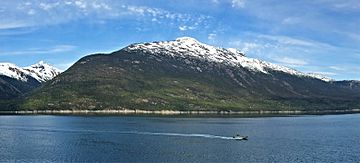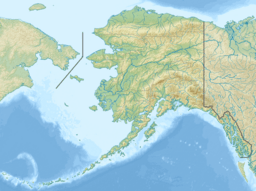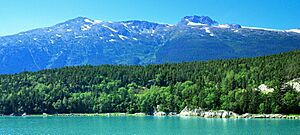Face Mountain facts for kids
Quick facts for kids Face Mountain |
|
|---|---|

Southeast aspect of Face Mountain
|
|
| Highest point | |
| Elevation | 5,052 ft (1,540 m) |
| Prominence | 580 ft (180 m) |
| Isolation | 1.36 mi (2.19 km) |
| Geography | |
| Location | Tongass National Forest Skagway Borough Alaska, United States |
| Parent range | Coast Mountains Boundary Ranges |
| Topo map | USGS Skagway B-2 |
| Climbing | |
| Easiest route | Scrambling |
Face Mountain is a mountain peak in Alaska, United States. It stands about 5,052 feet (1,540 meters) tall. This mountain is part of the Boundary Ranges within the larger Coast Mountains.
You can find Face Mountain about 4.2 miles (6.8 km) west-northwest of Skagway. It is also 4.3 miles (6.9 km) north of Mount Harding. The land around the mountain is managed by the Tongass National Forest.
Even though it's not the tallest mountain, Face Mountain rises very steeply from the water. It goes from sea level at Taiya Inlet to its summit in less than 2.5 miles (4.0 km). This makes it look very impressive!
The Story Behind Face Mountain's Name
This mountain has had a few different names over the years. In 1897, the U.S. Coast and Geodetic Survey first named it "Parsons Peak."
Locally, people also called it "Gnome Mountain" or "The Sphinx." These names came from a rock formation on the mountain that looks like a face.
In 1985, the U.S. Board on Geographic Names officially decided on "Face Mountain" as its current name. However, some older maps from the USGS still show it as "Parsons Peak." Water from the mountain flows into streams that lead to Taiya Inlet.
Weather and Climate at Face Mountain
Face Mountain has a subarctic climate. This means it has very cold, snowy winters and cool summers.
The weather here is greatly affected by systems coming from the Gulf of Alaska. When these weather systems hit the Coast Mountains, the air is forced upwards. This process is called orographic lift. It causes a lot of rain and snow to fall on the mountain.
Temperatures can drop very low, sometimes below -20 °C (-4 °F). With the wind chill, it can feel even colder, below -30 °C (-22 °F). Because of this cold climate, there's even a glacier located north of the mountain's summit.
If you want to visit or climb Face Mountain, the best time is usually from May through July. The weather is most favorable during these months.



